A failed golf course that neighbors turned into the Vistoso Trails Nature Preserve
I find this a fascinating and inspiring site. For me, it illustrates a shift to a much more alive and inclusive alternative to golf courses as a common green space around which vibrant and active communities can rally or be built. It strives to celebrate, and collaborate with, the unique local ecology and history, rather than build over it.
Currently, it has a hint of the post-apocalyptic with the dried-up turf, empty artificial lake, and boarded up clubhouse; but also very uplifting and joyous experiences as it is a very popular walking, bicycling, and wildlife-watching route entirely free of the noise, pollution, and danger of cars.
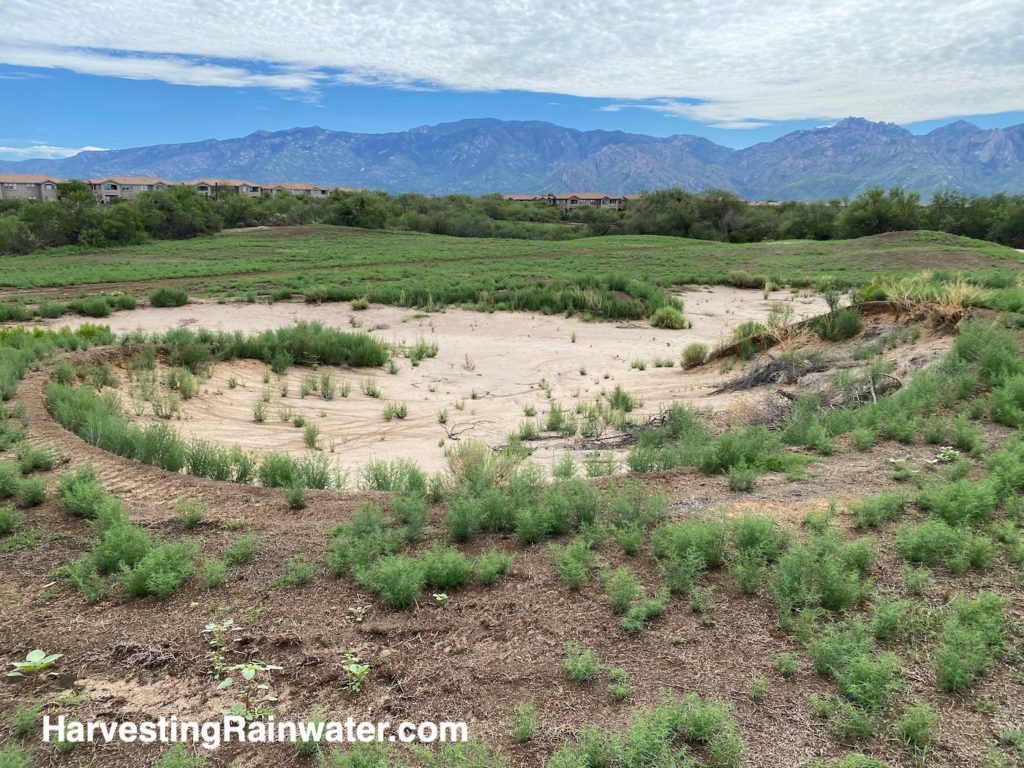
Photo: Brad Lancaster, 8-2022
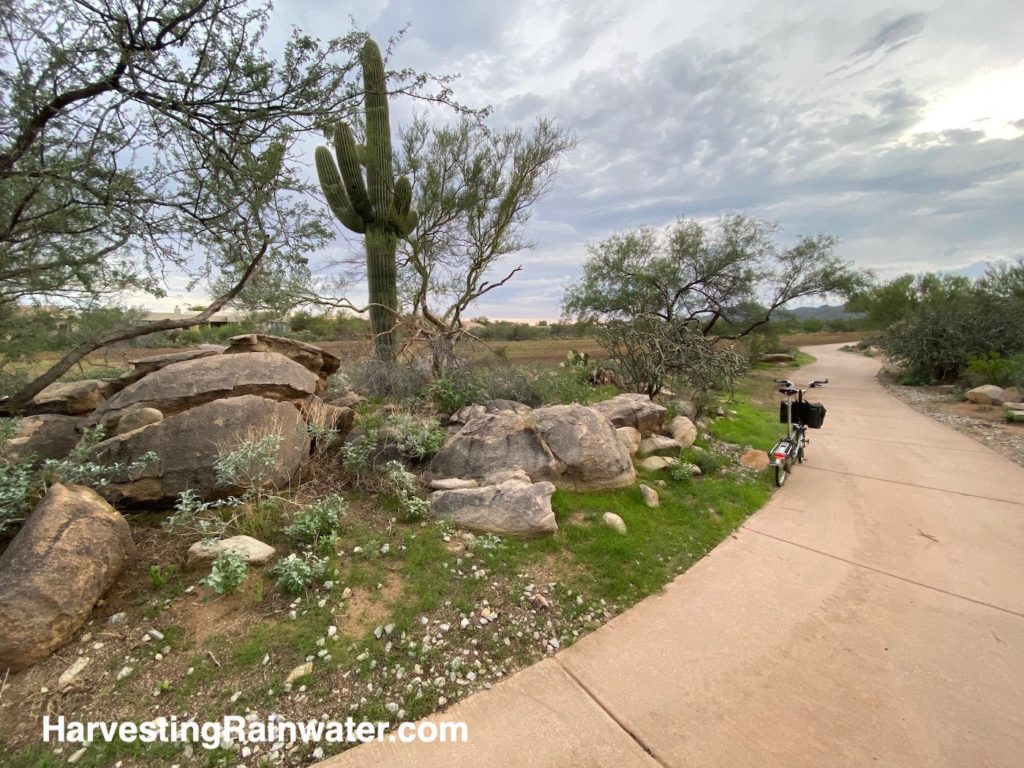
Photo: Brad Lancaster, 8-2022
Car-free delight
There are over 6 miles (10 km) of gently meandering and rolling, wide, paved, car-free paths that connect seventeen neighborhoods with underpasses beneath all major roads; beautiful views of the adjoining Catalina and Tortolita Mountains; ancient petroglyphs; and abundant native flora and fauna.
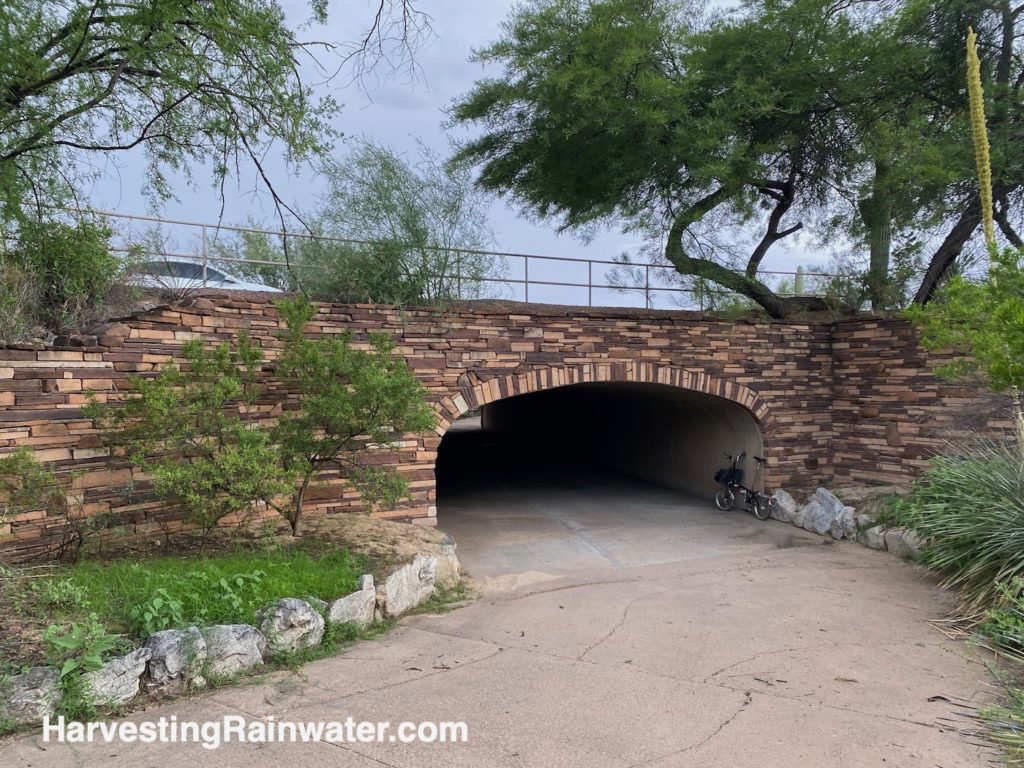
Photo: Brad Lancaster, 8-2022
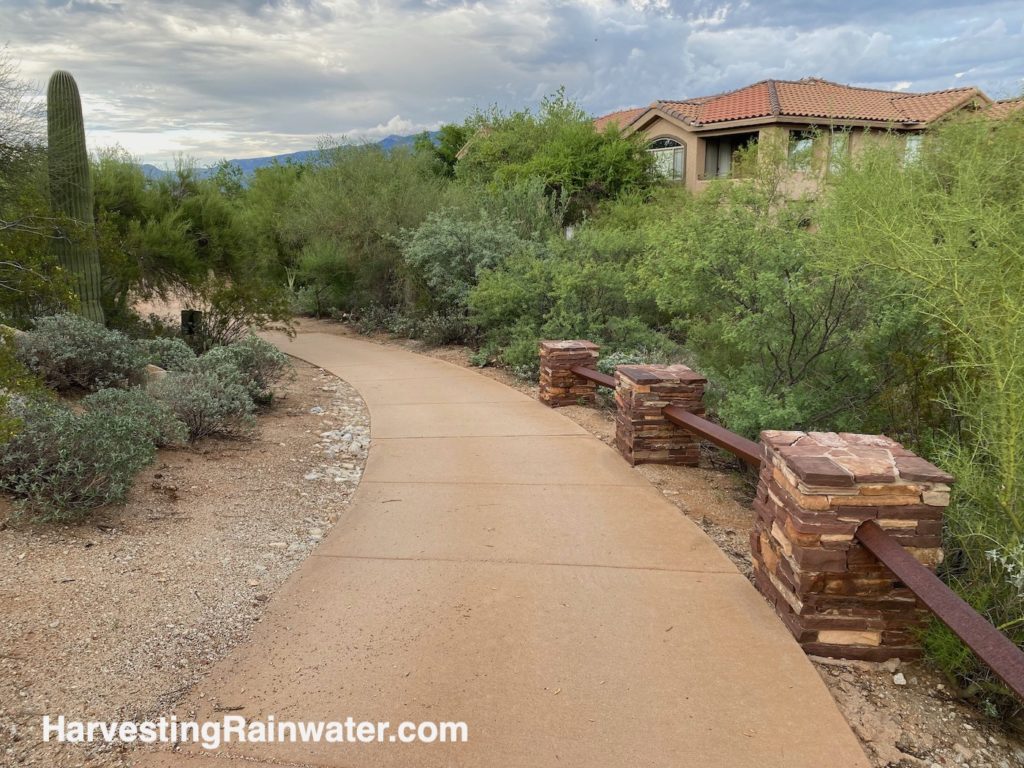
Photo: Brad Lancaster, 8-2022
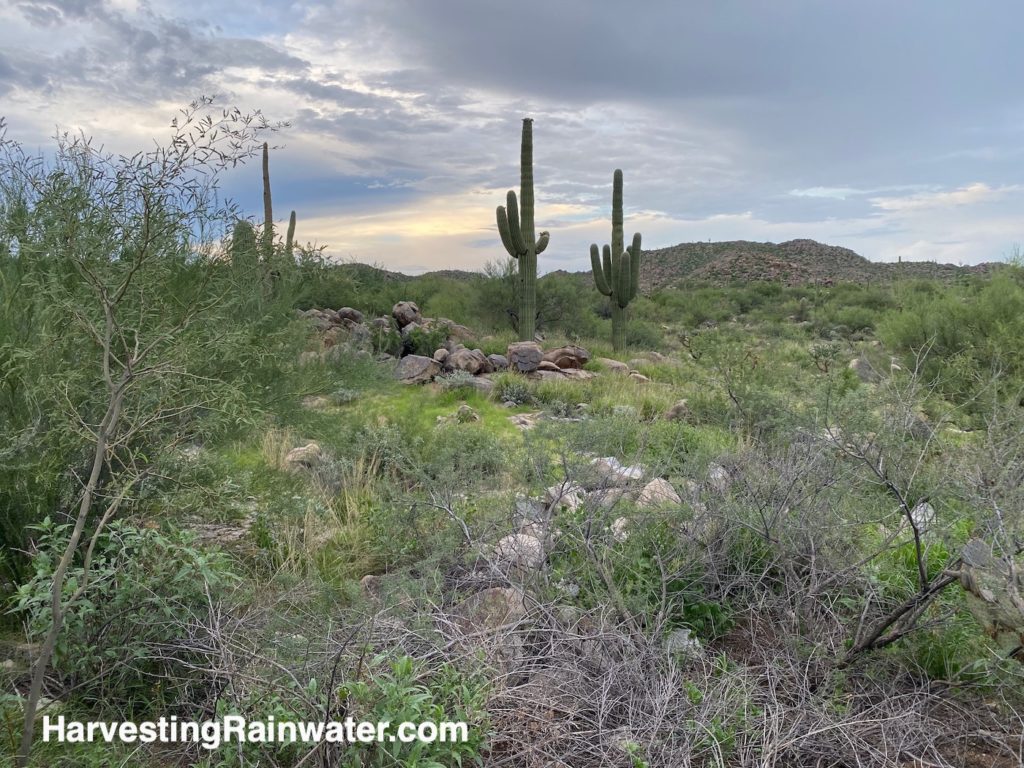
Photo: Brad Lancaster, 8-2022
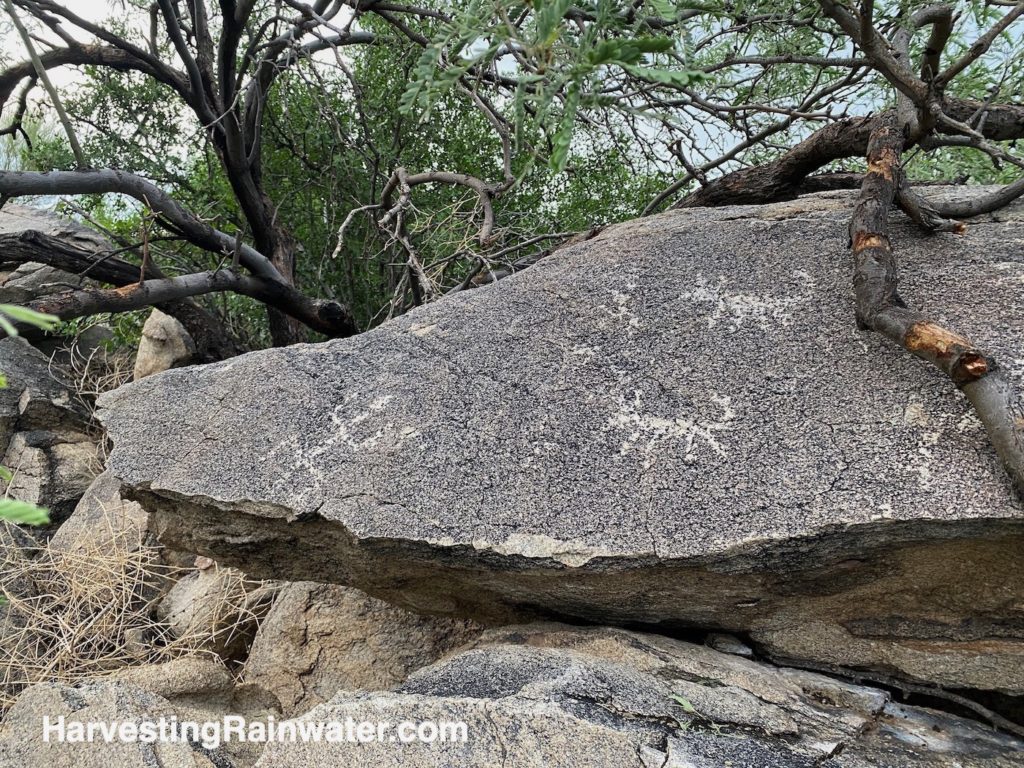
Photo: Brad Lancaster, 8-2022
I love it! It is so easy to power oneself (by bicycle is my favorite) with a little exercise throughout the beautiful landscape. Though in my opinion, it would have been even better if the golf course’s fairways had never removed or covered up the amazing vegetation, archaeological sites, and geology it did.
An evolving transformation that likely foreshadows our future
The site will continue to transform over time, as the golf course’s sand traps and turf areas are reclaimed by more drought tolerant vegetation. So, I highly recommend you visit now, and again later to experience the transformations.
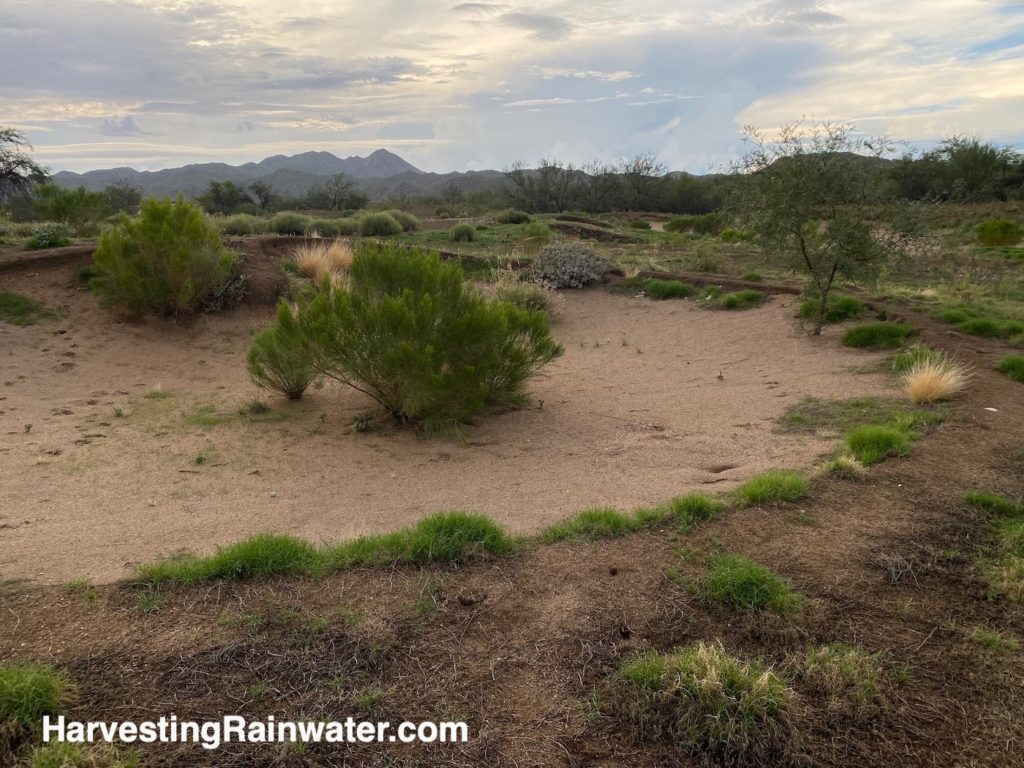
Tortolita Mountains in the background.
Photo: Brad Lancaster, 8-2022
I first visited in the monsoon season of August 2022, with the news abuzz with two related stories:
• Rapidly dropping water levels in Lakes Mead and Powell, and how Arizona and all the other states over-consuming the over-allocated waters of the dwindling Colorado River must make drastic cuts in their water use now before the river’s reservoirs become depleted dead pools.
• Arizona golf courses use way more water than they are supposed to. While Arizona golf courses use 2% of the state’s water, they use 9% of water consumed in municipal areas. And the $4.6 billion of annual revenue they make represented only 1.2% of Arizona’s economy in 2019.
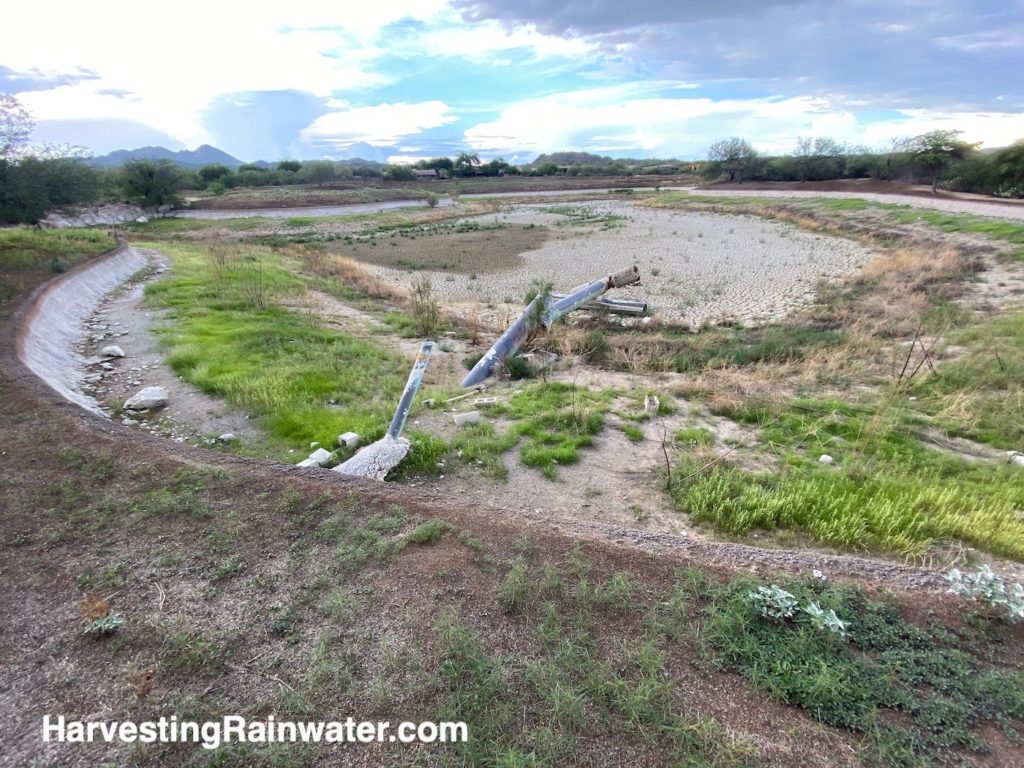
Photo: Brad Lancaster, 8-2022
This former golf course with irrigation system now shut off, currently consumes no municipal water, reclaimed water, groundwater, nor Colorado River water. Yet much of the site is lush where the diverse native vegetation was never removed. And since that native vegetation is the best adapted for our local climate and soils, it has never needed, nor been on, irrigation water.
Thankfully, the Tom Weiskopf-designed Rancho Vistoso golf course removed less native vegetation than most golf courses do, by reducing the need for more turf by leaving the existing native vegetation in the perimeter rough and out of bounds areas of the course, along with the section of fairway closest to the teeing grounds.
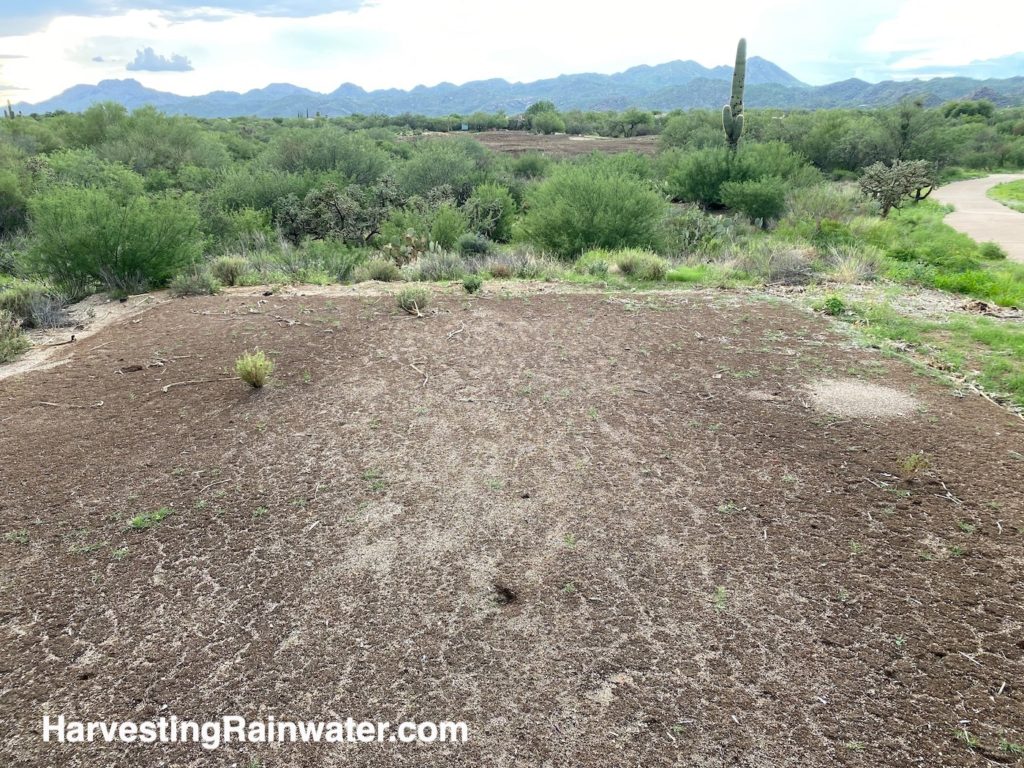
Photo: Brad Lancaster, 8-2022
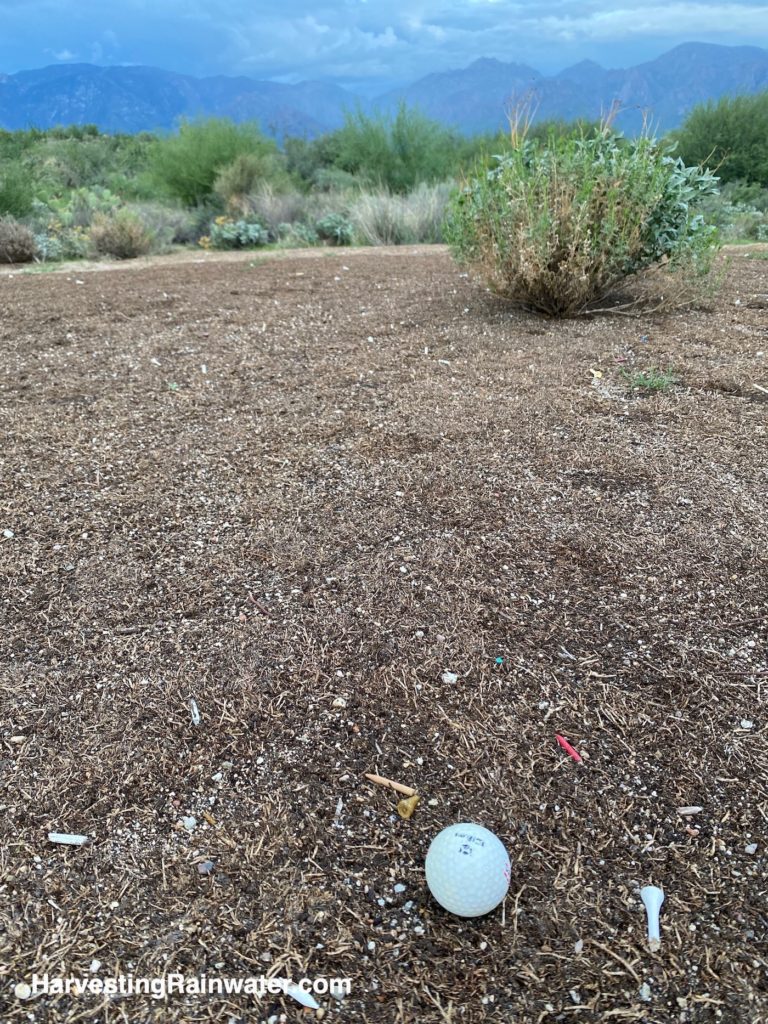
Photo: Brad Lancaster, 8-2022
Nonetheless, large swaths of once-turf-covered tee areas, fairways, and putting greens must now be restored with native plant cover. The dead turf currently acts as a 4-inch (100-mm) thick mulch, but it is largely devoid of plant life, and nature has evolved to fill and heal such voids. Thus, many invasive, non-native plants such as bufflegrass, Bermuda grass, and tumbleweed have started to move in to fill the void, along with native plants.
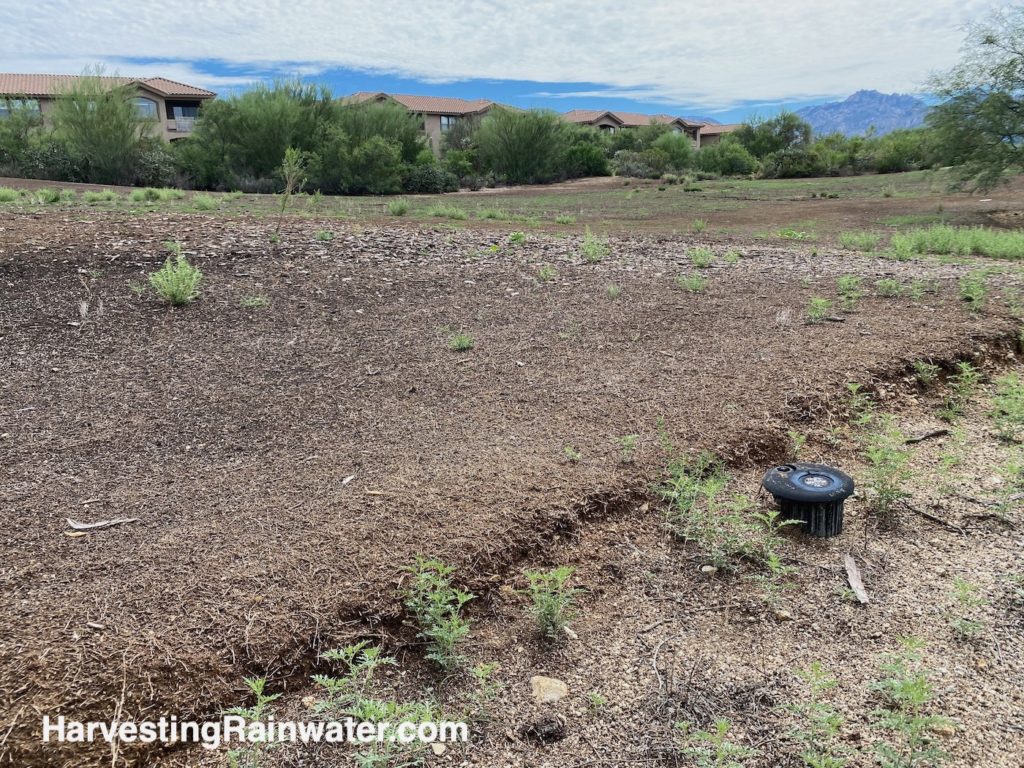
The dead turf now acts like a 4-inch (10-cm) thick mulch.
Black irrigation sprinkler on the right.
Photo: Brad Lancaster, 8-2022
Native plants are superior to non-native, invasive plants in that they offer the best wildlife habitat, since the native wildlife has co-evolved with the native vegetation and its blooming and fruiting times and nutrients. Thus, a non-native plant is often a relative dead zone supporting a fraction of the diversity of wildlife of a similar native plant. The native plants also tap into, and connect us with the rich native food history of this place and its people—there are over 400 native food plants in the Sonoran Desert. While many of the invasive, non-native plants such as buffelgrass and tumbleweed increase fire risk, while the natives (which have evolved in a non-fire-prone ecology) do not.
Makes me ask, why not forego the golf courses, and just create/preserve such natural and accessible community preserves at the core of neighborhoods from the get go?
This practice would enhance, rather than deplete our water resources.
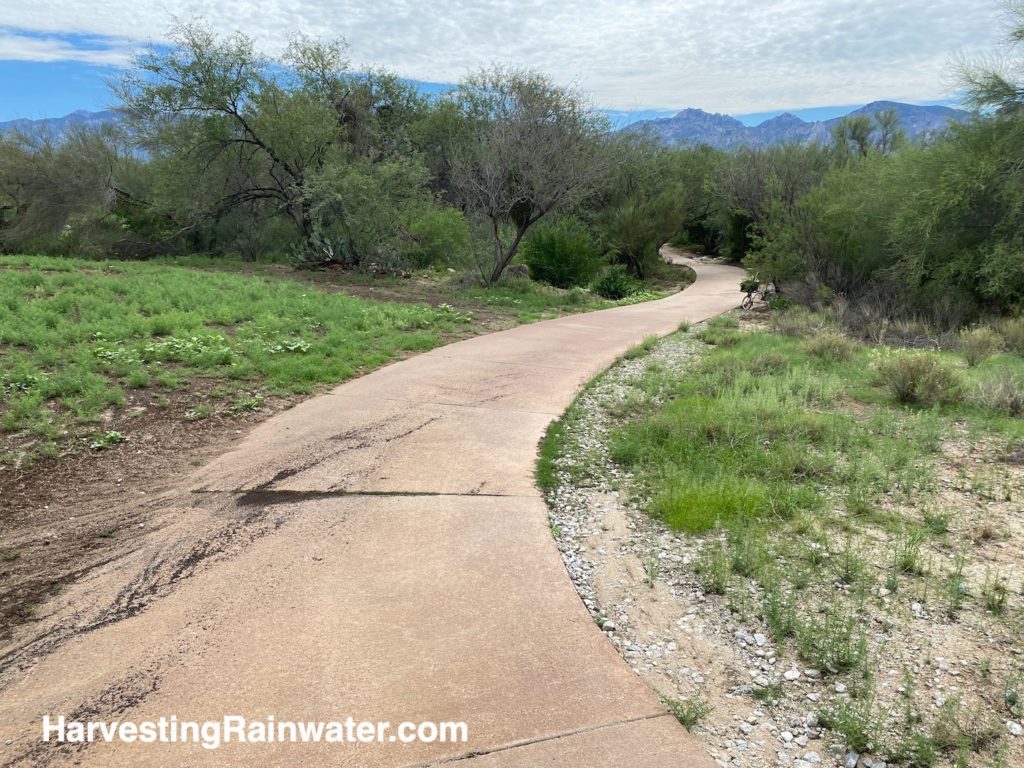
Dense and diverse native food forest in the background, requiring NO supplemental irrigation.
Photo: Brad Lancaster, 8- 2022
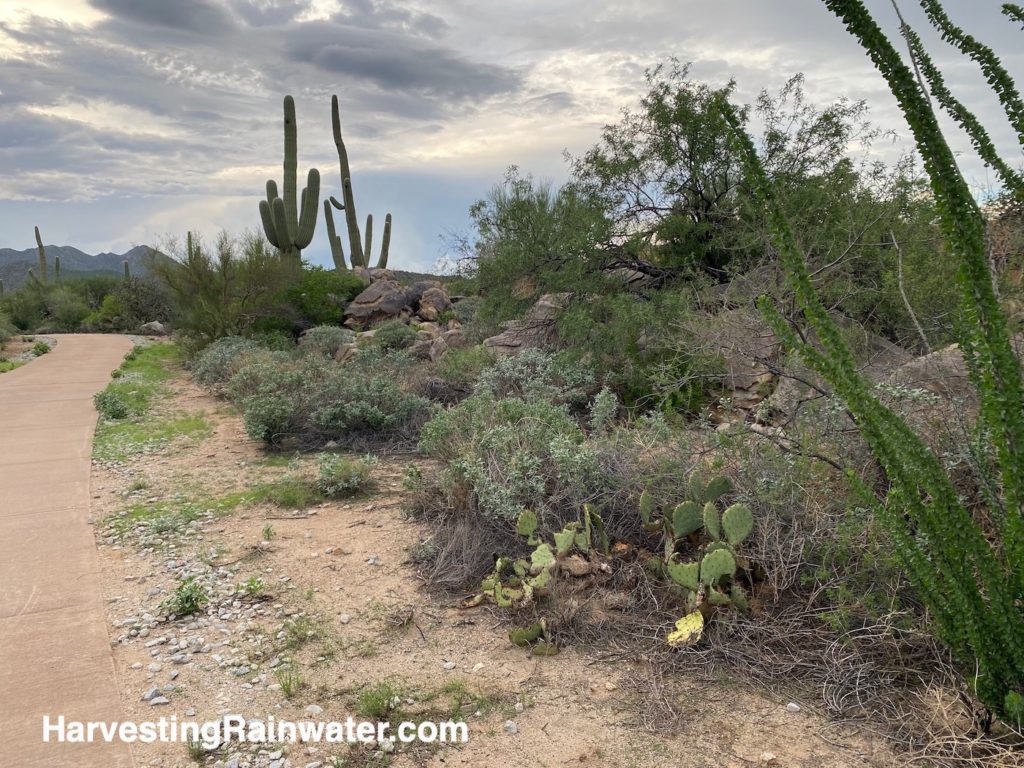
Photo: Brad Lancaster, 8-2022
Passive water harvesting potential
There is incredible potential to use passive water harvesting to jump start the reclamation of dead turf with diverse, multi-use native plant guilds. By tweaking the golf course topography with simple water-harvesting earthworks that retain, rather than drain the rain and stormwater runoff, most or all irrigation could be provided for free; while also reducing downstream flooding and helping recharge local groundwater and wells. These earthworks could be made largely invisible to the untrained eye by utilizing gradual, rolling slopes and water-capturing basins similar to, but much more effective than, the surrounding natural topography and that of the old golf course. Water-harvesting topography makes the most of the water that falls freely from the sky and drains off pavement, while also growing, capturing, and holding onto more organic matter (like leaf drop, seed, and insect and animal manures) which creates a living sponge that rapidly absorbs water when it rains, and then holds onto it much longer into the dry season so more life can sustainably thrive.
See the full-color editions of Rainwater Harvesting for Drylands and Beyond for more.
Nursery-grown native plants could be planted within and beside the water-harvesting earthworks, then supplementarily irrigated for the first one to three years to get them established. After establishment they could be taken off supplemental irrigation.
Or native plants could be planted by seed (ideally at the beginning of the rainy season) directly within and beside the water-harvesting earthworks. Typically no supplementary irrigation is needed with this approach.
Here is an example of planting seed in water-harvesting earthworks in an urban setting.
Here is an example of plants self-seeding in water-harvesting earthworks in an urban setting.
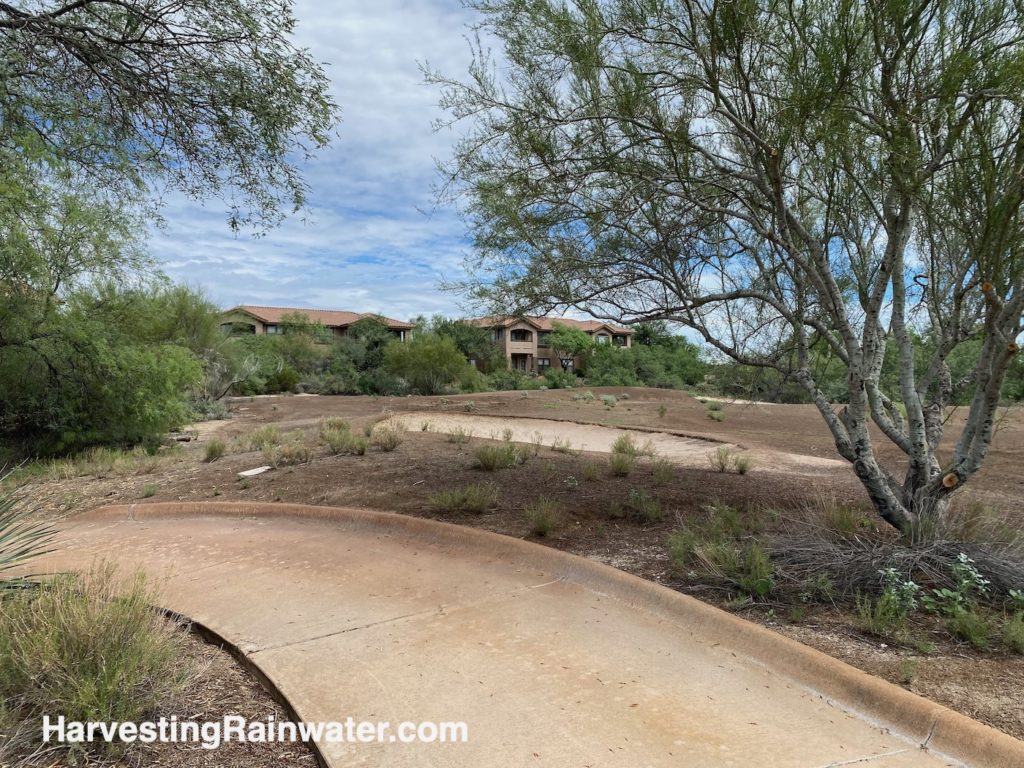
Note how white the usually green foothills palo verde tree trunks (on right) are from what I think are calcium deposits resulting from years of calcium-dense irrigation sprinkler water hitting the tree.
Photo: Brad Lancaster, 8-2022
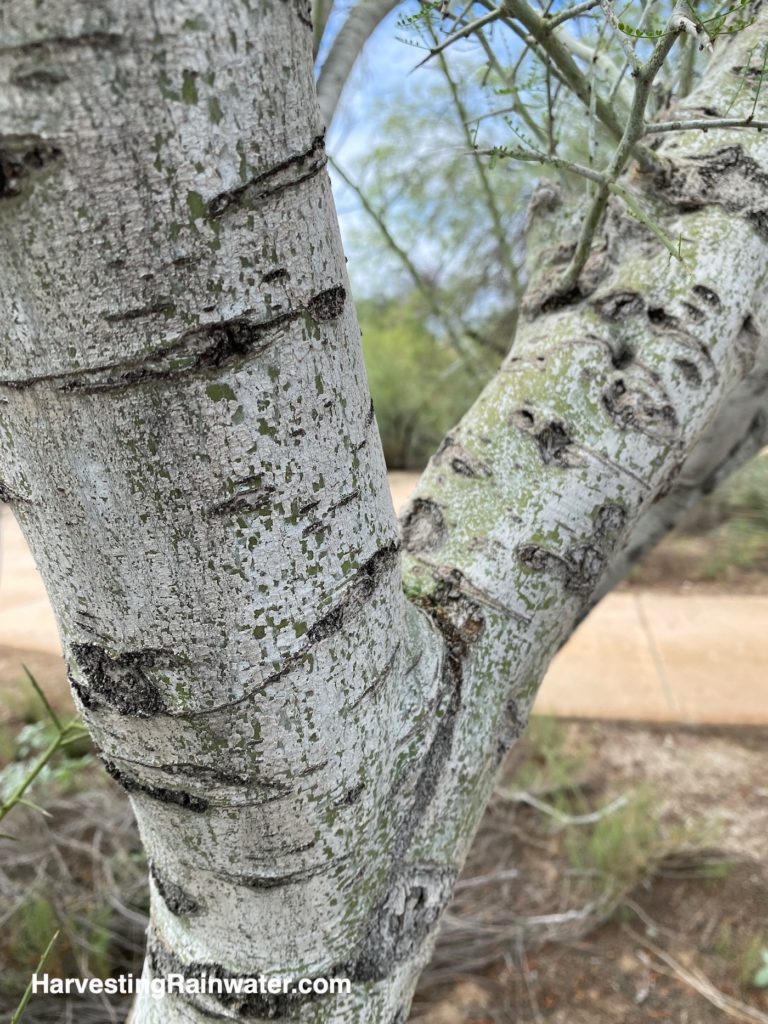
Note that rainwater contains no calcium or salts, and is better for the vegetation and soil life.
Photo: Brad Lancaster, 8-2022
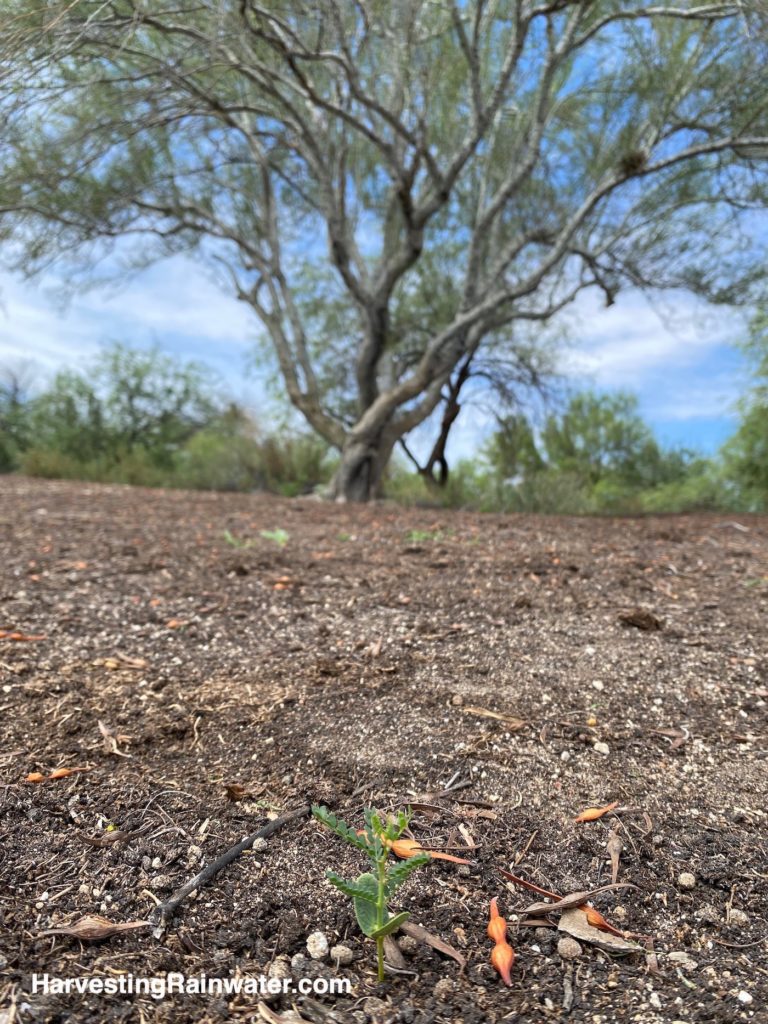
The mother tree, and source of the seed, in the background.
Photo: Brad Lancaster, 8-2022
Recent history of Vistoso property from private golf course to public preserve
In 1995 the 208-acre (84 ha), 18-hole, Rancho Vistoso golf course opened. You had to pay to play, and the public could not walk on the course’s six miles of concrete trails winding through 17 residential developments when play was on.
In 2015, amid rising water prices and lagging use, the golf course operator, IRI Golf Group, defaulted on its mortgage. Romspen, a Canadian-based, non-bank mortgage lender, then bought the property out of bankruptcy, but did not succeed in reselling it as a golf course, and closed the golf course for good (and shut off the irrigation system) in 2018.
In 2018, once the golf course closed, neighbor Rosa Dailey and a few other neighbors started an organization called Preserve Vistoso to fight development offers. They applied for and received 501(c)3 non-profit status. They educated themselves on conservation law, spoke with neighbors and lawyers, attended city council meetings, met with city council members, wrote letters, got local press, and refined their vision. Preserve Vistoso interest and members grew.
In 2020, Rompsen tried to rezone the property for buildings, and sell to developers; but met fierce resistance from the surrounding community.
Preserve Vistoso then reached out to, and partnered with the national non-profit, The Conservation Fund, which helps communities with their conservation efforts.
October 2021, The Conservation Fund signed a contract with Rompsen to purchase the 202 acres (81.7 ha) of the golf course property, while a 6.3-acre (2.5 ha) parcel near the former clubhouse would be sold to a developer.
The town of Oro Valley agreed to facilitate the agreement.
Preserve Vistoso’s 1,800 members raised $1.8 million within weeks of the agreement for The Conservation Fund to purchase the property.
February 2022, the Conservation Fund purchased the 202 acres.
July 8, 2022, the Conservation Fund donated the property to the Town of Oro Valley.
Aerial view of the former Rancho Vistoso golf course turned Vistoso Trails Preserve
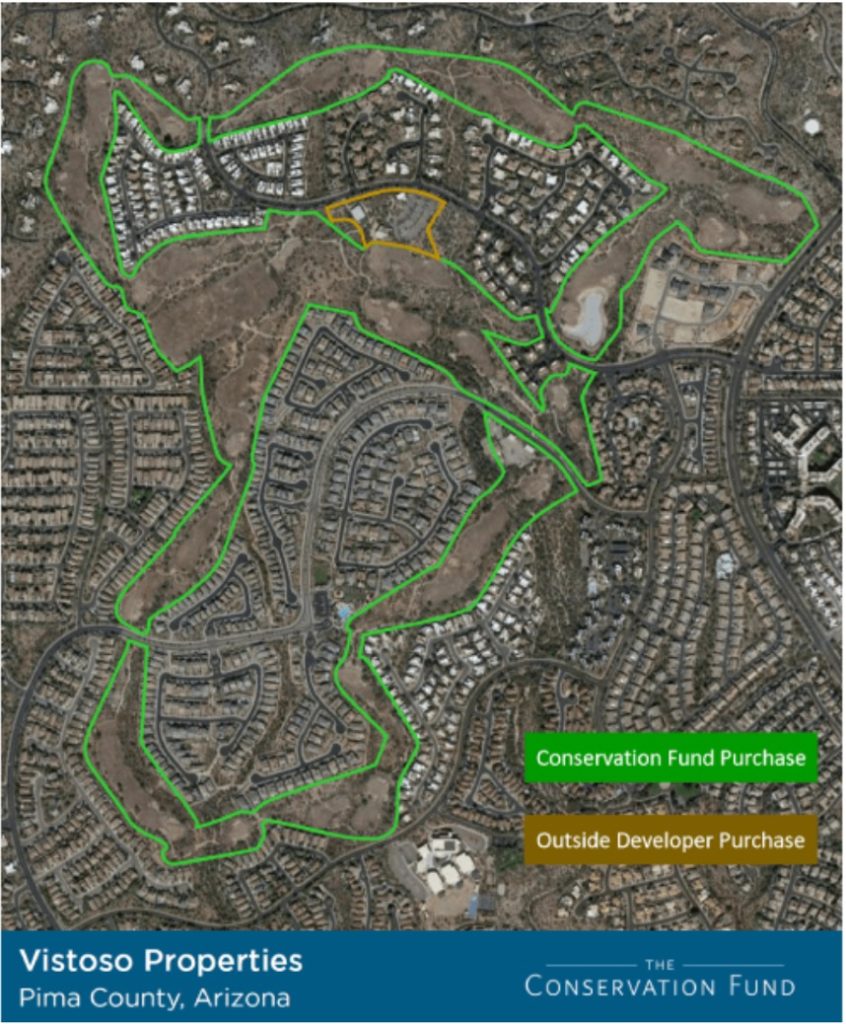
Where:
955 W Vistoso Highlands Dr, Tucson, AZ 85755
32.456895, -110.983161
The current trailhead to the Vistoso Trails Nature Preserve is at the parking lot and boarded up club house of the old Rancho Vistoso golf course.
This may change somewhat in the future, if and when the club house site is redeveloped, though it is very easy to see and enter the nature preserve and its tan-tined concrete paths because sections (including the dried up lake) can easily be seen to the side of the road as you approach the site.
Hours: 6am to 10pm
Cost: free
Dogs allowed on leash
For more…
• See comparative photos of when the golf course was in use (and irrigated), and after it was closed (and irrigation had ceased), along with current human uses, and wildlife sightings here. Then scroll down halfway to see the before and after photos.
• More of the story on how neighborhood activists turned the golf course into a nature preserve here.
• Preserve Vistoso field guide
• Preserve Vistoso background & timeline history
• Video channels that highlight fantastic car-free spaces/infrastructure for walkers, runners, bicyclists, skaters, wheelers, and more:
Not Just Bikes
Bicycle Dutch
This location is included in the following tours:
See the new, full-color, revised editions of Brad’s award-winning books
– available a deep discount, direct from Brad:

Volume 1
This is THE book to start with as it shows you, your community, and your watershed, how to assess all your free, on-site waters (rainwater, stormwater runoff, greywater, dark greywater, condensate, etc.); then create an integrated plan to start harvesting those waters.

Volume 2
This book gives you step-by-step instruction on many different ways how to plant the rain, stormwater, greywater, and condensate within water-harvesting earthworks or rain gardens for many different contexts to grow regenerative abundance.
